Sony FE 16-35mm F2.8 GM II Review
Dustin Abbott
January 3rd, 2024
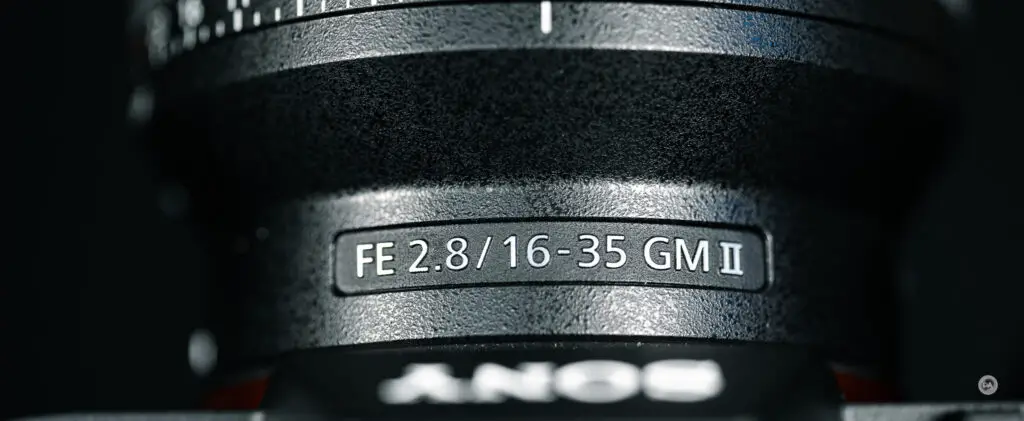
Sony release the first generation 16-35mm F2.8 Gold Master (GM) lens in 2017, making it the third GM zoom lens for E-mount and completing the “trinity” of fast F2.8 zooms along with the 24-70mm F2.8 and 70-200mm F2.8 GM zooms. This lineup of zooms is pretty much considered a requirement for any platform to be considered “professional-ready”. There would be a three year gap before another GM zoom was released (the 12-24mm F2.8 GM was released in 2020), and during that period Sony was going through a true renaissance of lens design. The first generation of GM lenses were good, but far from perfect. The second generation of GM glass has consistently been some of the best lenses of their kind that I’ve ever tested…period. In 2021 Sony released the MK II version of the 70-200mm; in 2022 they released the 24-70mm F2.8 GM II, and thus it stood to reason that 2023 would be the year of the 16-35mm F2.8 GM II. The 16-35GMII returns with the modern Sony design of features, autofocus, and performance. So is it worth the nearly $2300 USD price tag? Find out by watching my video review below…or just read on.
Follow Me @ YouTube | Patreon | Instagram | Facebook | DA Merchandise | Flickr | 500px | X
Thanks to Sony USA for sending me a review loaner of this lens. As always, this is a completely independent review. *The tests and most of the photos that I share as a part of my review cycle have been done with the Sony a7RV along with the Sony Alpha 1 that serve as my benchmark cameras for Sony lenses.
__________________________________________________________________________________________________
Sony has had four priorities in their updates to the GM lenses:
- Make them smaller
- Modernize the feature set
- Improve the autofocus speed and accuracy via multiple XD linear motors
- Improve the optical performance
All of these priorities are realized here, as at 547g, the 16-35GMII is 20% lighter along with being about 10mm shorter than the first generation lens. It has the full modern feature set, included multiple focus hold buttons, an aperture ring, iris lock, and an aperture declick option. Autofocus is lightning fast due to the use of quad!!! XD linear motors. And the optical performance has been improved to the kind of edge to edge perfection that Sony’s modern GM lenses achieve.

Add to this the fact that the 16-35GMII can focus more closely than before and now gives a very impressive 0.32x magnification, which greatly adds to the versatility of the lens.

In short, this is a modern Sony GM lens, and that means that owners of the original G Master lens now have a hard decision to make.
Build and Handling
As noted in the intro, the new 16-35GMII lens is packed with upgraded features and build tweaks. That begins with a reduction in size, with the new lens being 87.8mm (3.5″) in diameter (as before) but now 111.5mm (4.4″) in length (compared to 121.6mm for the first gen lens). The most notable reduction is in weight, however, with the new lens weighing in at 547g (1.2 lb) compared to the 680g (1.5lb) of the previous lens. There aren’t any direct competitors to this lens, though Sigma’s 14-24mm F2.8 DN weighs in at 795g and Canon’s RF 15-35mm F2.8L IS weighs a whopping 840g. Even Tamron’s miniscule 17-28mm F2.8 with its reduced zoom range and featureless design weighs 420g. The 16-35GM II didn’t even feel too big for the compact a7CR camera I used it on a bit.
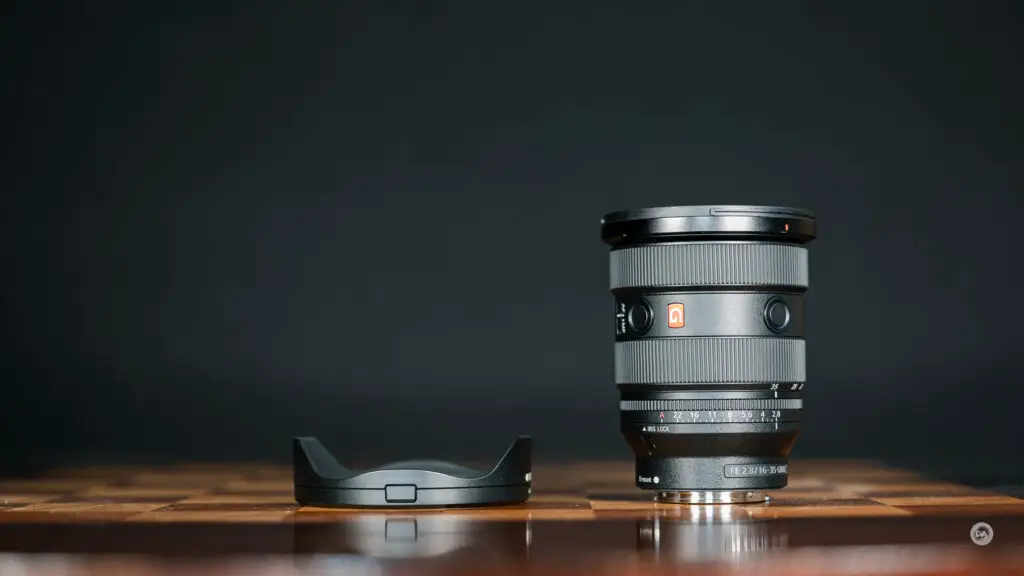
Here’s a look at a comparison chart of specifications with some of these lenses.
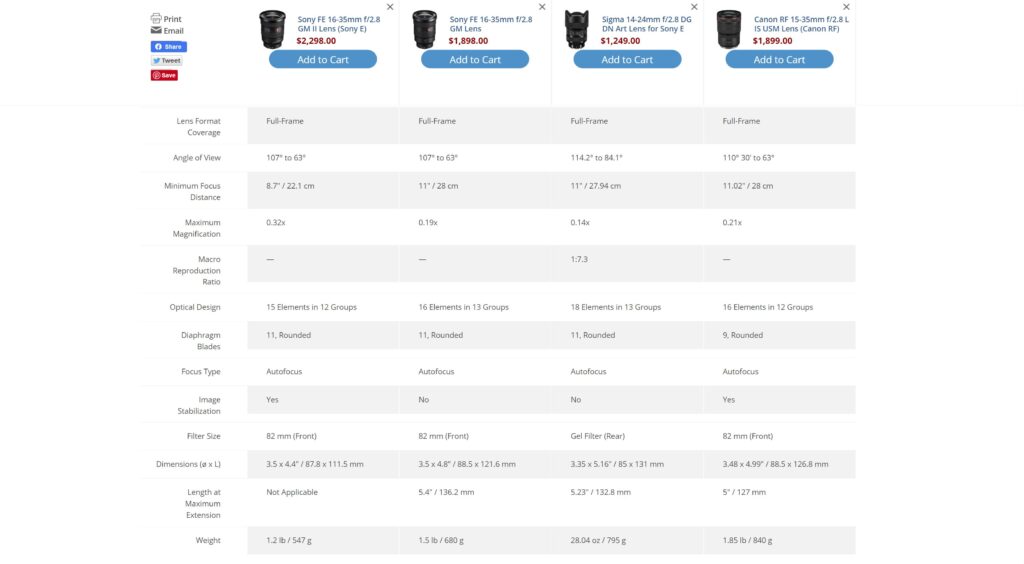
The feature set begins inside the lens, as the lens features a very thorough weather sealing that includes no less than 15 sealing gaskets by my count.
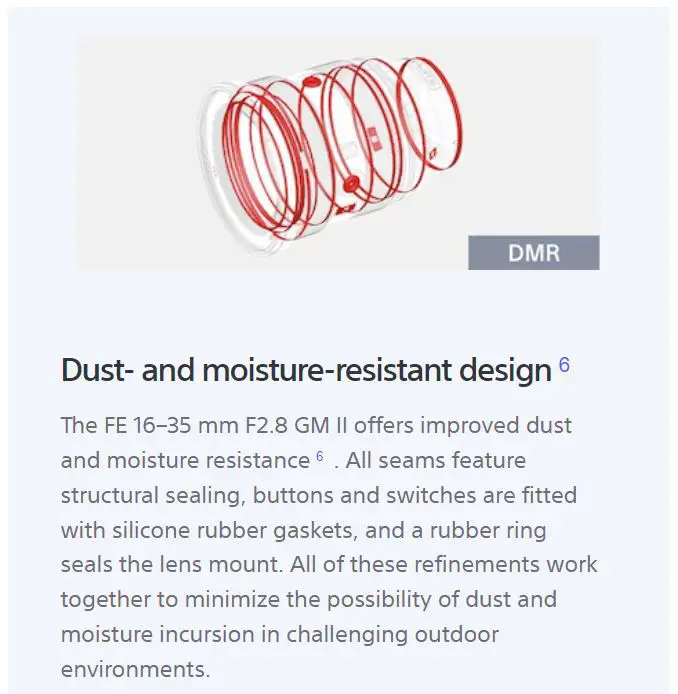
There’s also a fluorine coating on the front element to help resist fingerprints and moisture.

You can from the shot above see that the front façade of the lens is nice and clean. The filter threads are for 82mm filters (same as before). Sometimes wider lenses lose the ability to use traditional filters, so the fact that one can use common filters here is helpful.
The 16-35GMII now includes an aperture ring. This has been an increasing priority for Sony in their lens design due to the reality that more and more people are doing a hybrid of photo and video work on their Sony cameras. An aperture ring gives you more direct control over aperture along with a few extra options for what you can do with it.

Traditional aperture control comes in the form of a clicked ring with detents at every one-third F-stop. The clicks are well defined and easy to find.
Those who prefer smooth aperture control without clicks (either as a preference or for video aperture racks) will find a Click/Declick option on the right side of the lens barrel. In the declicked option you can smoothly rack through the whole aperture, though this is a “by-wire” or electronic control which will require the camera to be powered on to operate. There is also a little lag between input on the ring and the physical movement of the aperture blades.

If you find an aperture ring annoying and unnecessary, Sony also has an option for you. There is an Iris Lock on the left side of the barrel that will allow you to either lock out of the aperture ring (in Auto mode where aperture is controlled from the camera) or to lock you into the aperture ring to assure that you don’t inadvertently switch into auto mode.

These two switches are located discretely and designed in such a way that they won’t get inadvertently bumped.
The original GM lens had a single focus hold button over the AF/MF switch on the left side of the barrel. That original location for those two items is retained here.
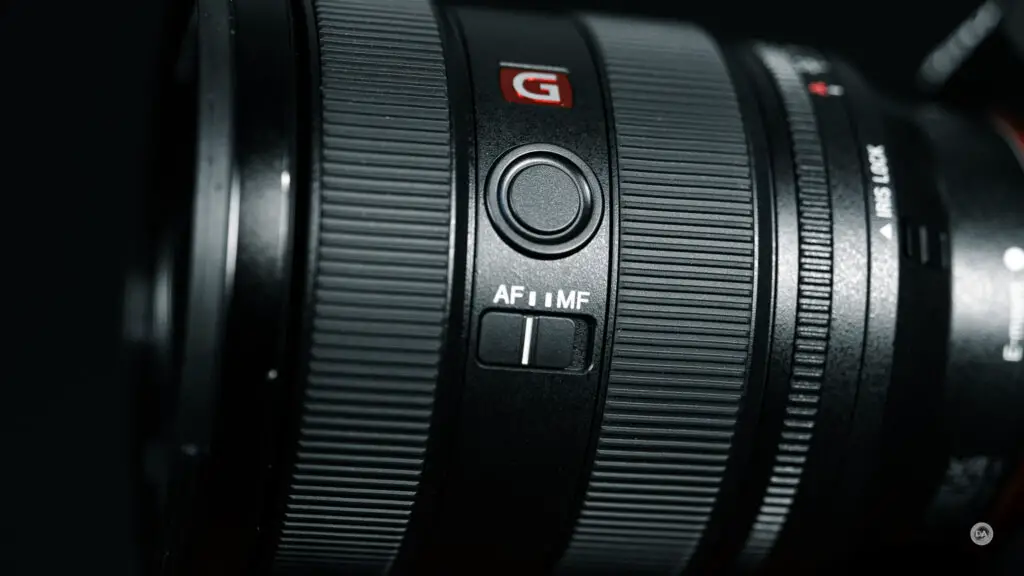
Sony has added an additional focus hold button to the top of the lens barrel so that when one is shooting in vertical mode there is still a focus hold button close to hand.
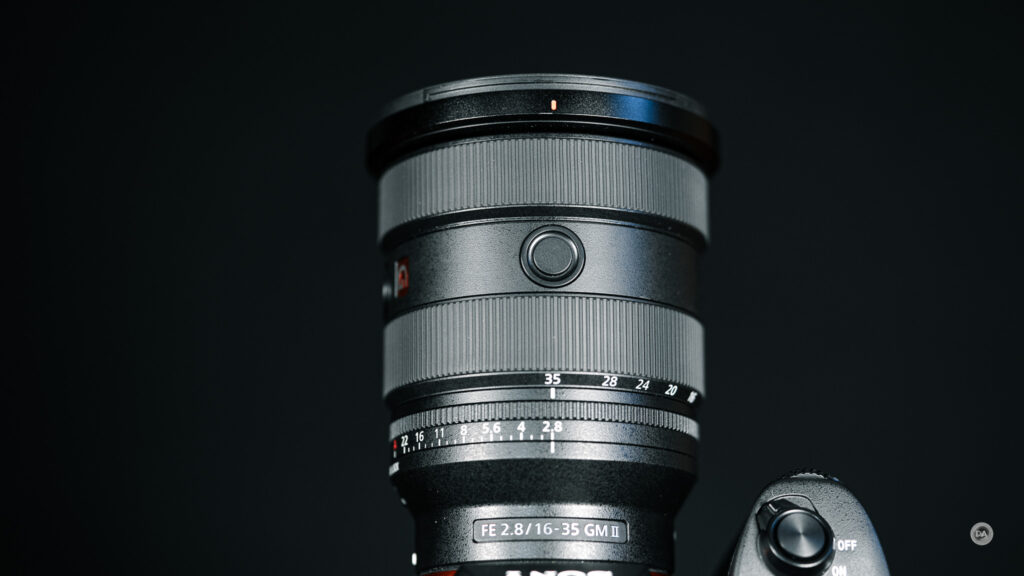
You’ll note that the front of the lens is fully retracted in the above image despite the zoom ring being at the 35mm position. The lens will extend a tiny amount (about 8mm) when zoomed to the 16mm position.
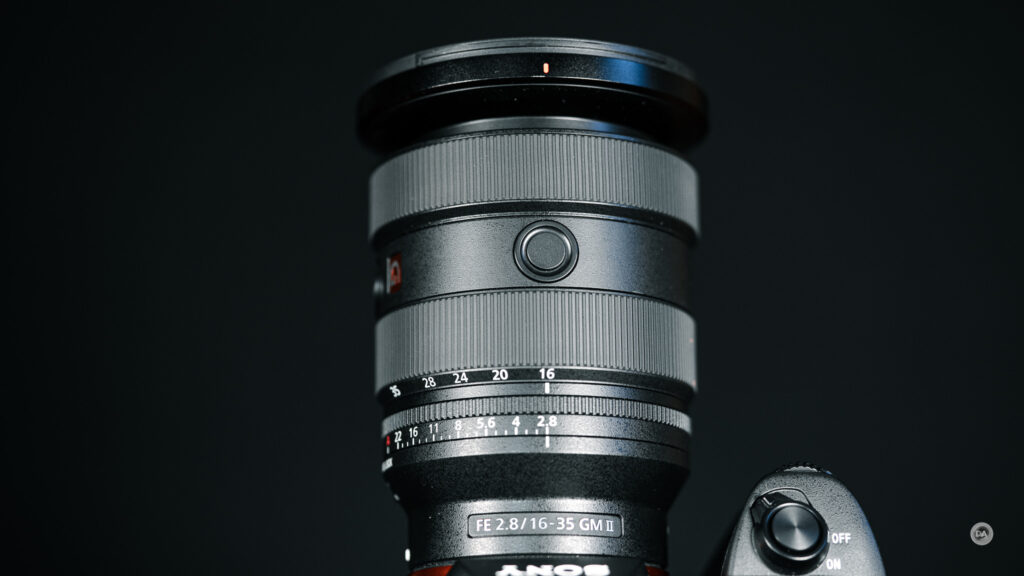
The design is intentional to allow for a good balance point for those using the lens on a gimbal. You shouldn’t have to recalibrate regardless of the selected focal length.
The zoom action is very smooth with good damping and no sticking points in the zoom range.
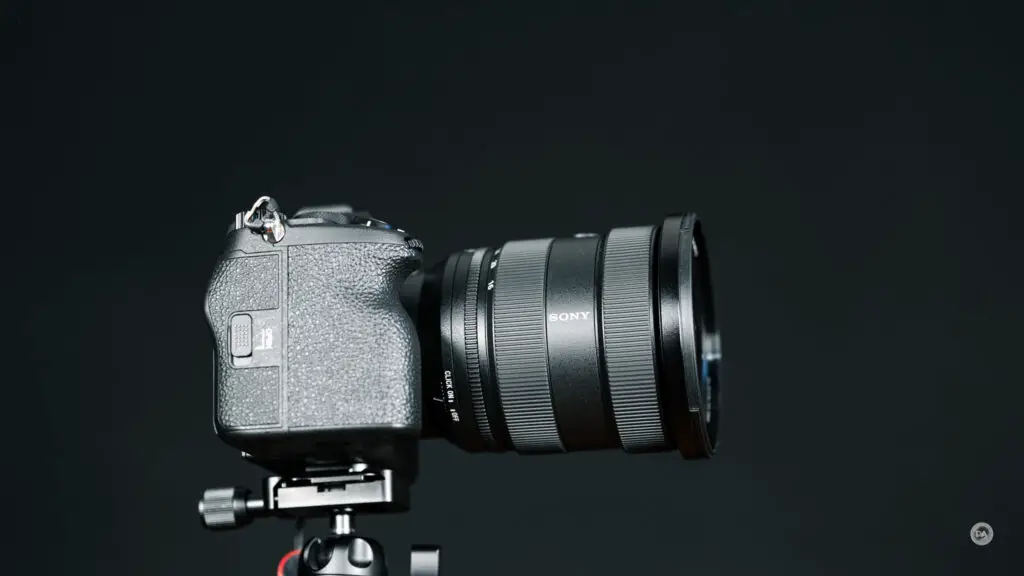
The manual focus ring is located near the front of the lens and moves smoothly with weight being on the lighter side. Doing one finger focus is easy. There isn’t an amazing amount of “feel” to the ring (also “by-wire”), but it gets the job done.
There is a very shallow lens hood that is included. It is plastic and nothing fancy, though there is a lock on the side to help keep it from moving.

As noted, the minimum focus distance has been improved to just 22.1cm (8.7″), allowing for a much higher 0.32x magnification (compared to just 0.19x for the original GM lens). This allows you to get very close to the subject and achieve a high level of magnification:

You can get a bit closer still at 16mm, but the magnification level isn’t nearly as high as what you can achieve at 35mm (16mm on the left, 35mm on the right):
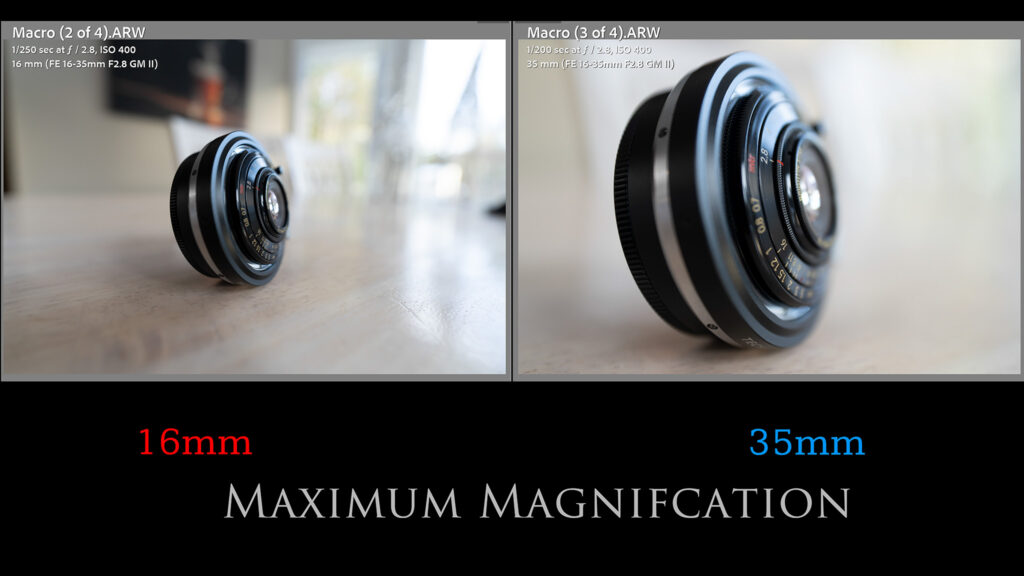
If we zoom into that image we find that up close performance is really quite good.
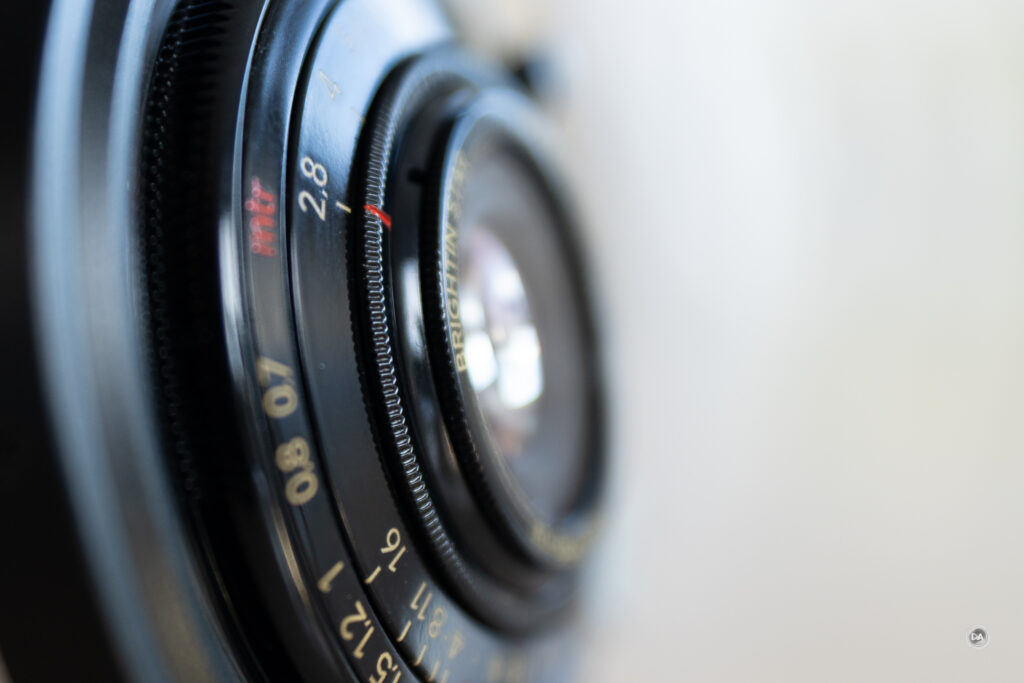
That obviously adds additional layers of versatility to the lens and the kinds of images you can make with it.
Sony has really hit on a winning formula for their modern GM lenses, and the 16-35mm F2.8 GM II is no exception. This lens does not have optical stabilization, but that’s in large part because Sony has fully committed to in body stabilization in all of their full frame cameras (unlike some other camera makers). I used the lens on three different Sony cameras and was able to get stable handheld video footage on all of them along with photos with lower shutter speeds.
The 16-35GMII is expensive at $2298 USD, but it is also the most fully realized, feature rich lens in the class. That’s kind of the point of the Gold Master series – to be the premium option for those willing to spend for it.
Autofocus and Video
I was rather astounded to discover that Sony had packed 4 XD (Extreme Dynamic) Linear Motors into the 16-35GMII. Wide angle lenses are typically less demanding on focus systems because so much stays in focus all of the time, but Sony wanted to be sure that this lens could keep up with incredibly fast bursts (like the on new Sony a9III or Alpha 1) or when recording video at 4K120.
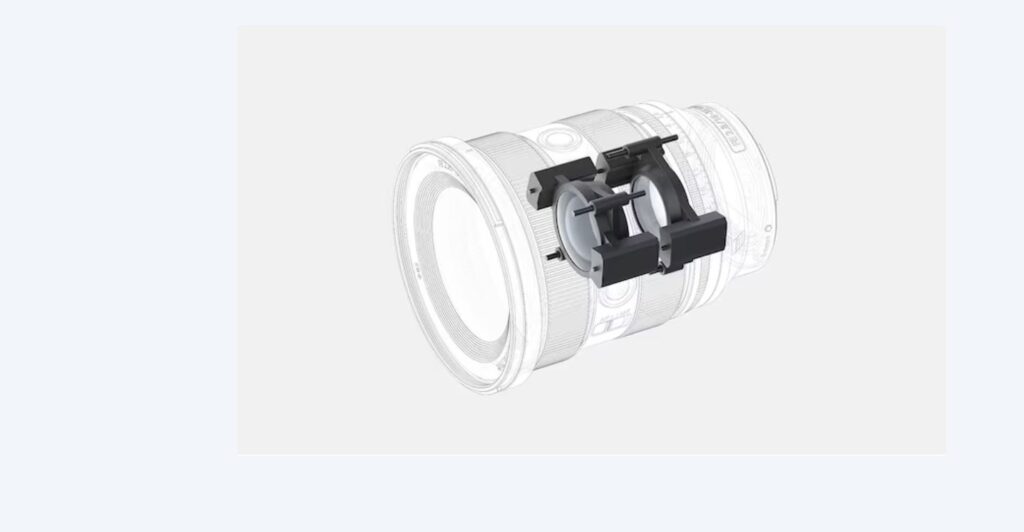
There is no better autofocus experience that I’m aware of than GM lenses so equipped on Sony’s better camera bodies. I own the Alpha 1, and the ability to shoot 30FPS with great precision is still an amazing experience. But even on less robust autofocusing cameras like the Sony a7CR that I happened to be reviewing, capturing action shots was effortless.

The XD motors are truly silent. I put my ear next to the barrel and focused multiple times. I then looked at the camera to make sure focus was happening because I couldn’t hear anything even in a quiet environment.
Focus speed is essentially instantaneous. And focus accuracy is exceptional, allowing you to accurately pinpoint focus even on very small targets.

Let’s zoom in so that we can appreciate the precise focus and incredible resolution.

Eye AF was extremely accurate. Unlike some brands, Sony has perfected the ability for focus to be on the iris rather than the eyelid or lash.


My focus speed tests showed near instant focus transitions from near to far and back. There’s no drama there; just instant lock on a new subject. My eye tracking test showed good “stickyness” as I moved around even when using my statue model rather than an actual human subject.
In real world situations I had no problem instantly locking focus even when subjects were in motion.

Things are also positive on the video side of things. My focus pull tests were smooth and confident. There is no visible stepping, no hunting or pulsing, and the subject locked without settling. Even better was my hand test where I alternately block the lens from seeing my face with my hand and then remove it and allow focus to transition to my eye. There was perfect confidence not only in the transition to my eye (the more easily trackable subject) but also on my hand.
Focus breathing is minimal and shouldn’t be an issue.
I shot a few video clips of basketball action and saw accurate focus and smooth focus transitions as the players moved around in space. All good.

I was perfectly happy with autofocus on the 16-35GMII on all three cameras I tested it on for both stills and video work.
Image Quality Breakdown
The 16-35mm F2.8 GM II is the rare second generation lens with a LESS complicated optical formula than its predecessor. It features 15 elements in 12 groups rather than the 16 elements in 13 groups of the previous lens…and delivers much stronger image quality at the same time. Sony’s ability to manufacture exotic glass elements has improved, and that is reflected in this formula that sports 5 different types of exotic lens elements. The MTF charts look excellent, with extreme high resolution in the center and midframe and corners that are sharper than what some lenses are in the center.
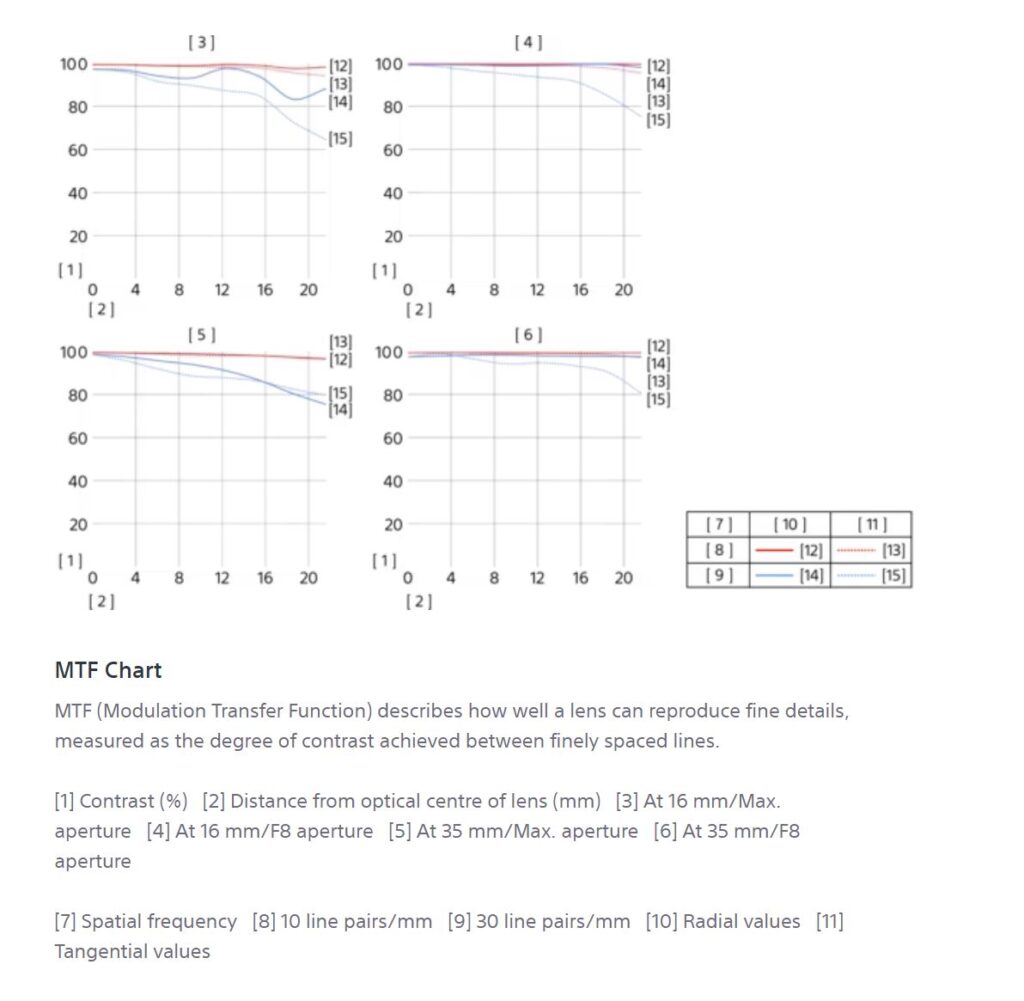

The MTF on the telephoto end, in particularly, speaks of a significant improvement. And the image quality is as pristine as a fresh winter snow here in Canada.

The biggest optical flaw I can find is the barrel distortion at 16mm. There’s a significant amount (a +24 to correct), but, more importantly, it is fairly complex. There’s a mustache type pattern that means that an attempt to correct most of the inner lines results in warping the outer lines. Fortunately Sony’s correction profile does a much cleaner job of resolving the distortion. At 24mm the distortion is fairly neutral, and by 35mm it has inverted to pincushion distortion, though a minimal amount that isn’t difficult to correct. Here’s a look at the three results and the manual corrections.
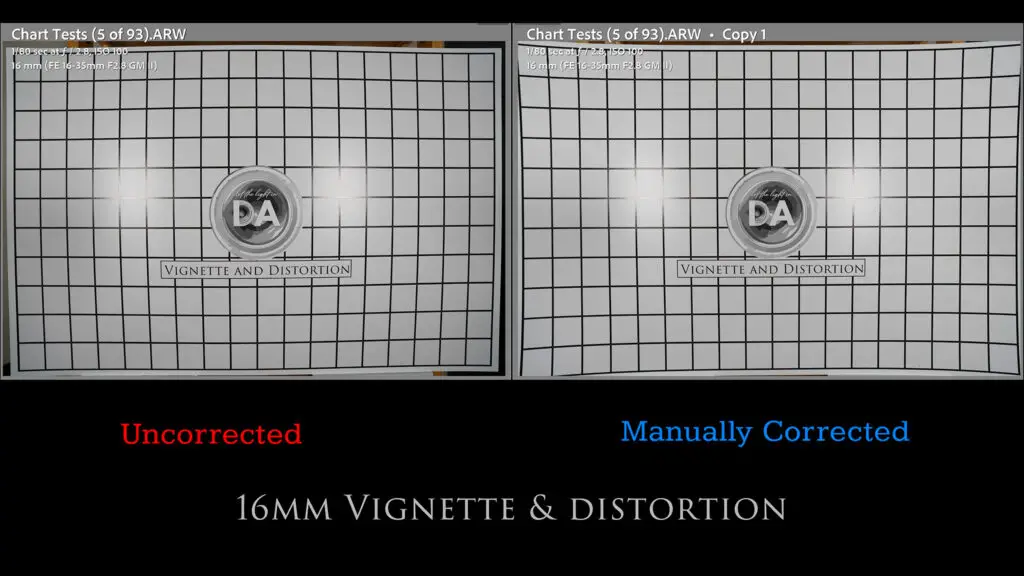


And here is the information for those corrections:
- 16mm: +24 to correct the distortion, +33 to correct the vignette (slightly over one stop)
- 24mm: 0 distortion correction, +35 to correct the vignette
- 35mm: -4 to correct the distortion, +23 to correct the vignette
Outside of that complex distortion at 16mm, everything here is pretty well controlled.
Chromatic aberrations are extremely well corrected, with almost no longitudinal chromatic aberrations (fringing) in narrow depth of field shots:

There is also no evidence of lateral chromatic aberrations near the edges of the frame:
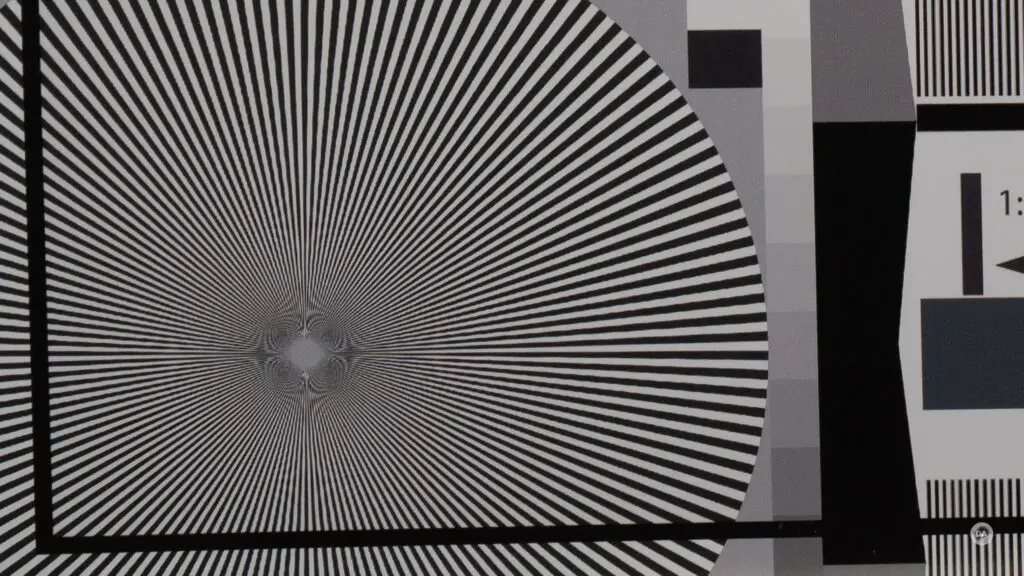
Frankly these days I don’t expect anything else from Sony’s GM lenses, but the lens definitely doesn’t disappoint in these tests.
So how about resolution? Here’s a look at the test chart we use for our tests:

I’ve done these tests on a 61MP Sony a7RV. Here’s a look at crops at nearly 200% at 16mm, F2.8 from the center, mid-frame, and lower right corner:



That’s pretty pristine, with great detail everywhere you look in the frame. That means that you can easily shoot landscape images at F2.8:

Here’s crops from that image from both edges and the center:



You’ll also note that contrast is pretty much perfect from F2.8 on in a real world environment, too.
You’ll get very mild improvements in detail and contrast when stopping down further, though the lens is already so sharp at F2.8 that you probably will hardly notice. Stopping down the aperture will be more useful for increasing depth of field than in an exercise to get more sharpness.

Image quality remains pristine through F8, though after this diffraction will start to soften the image, particularly on high resolution cameras. You can see there’s a radical difference in contrast between F8 and F22 (minimum aperture) in the corners:
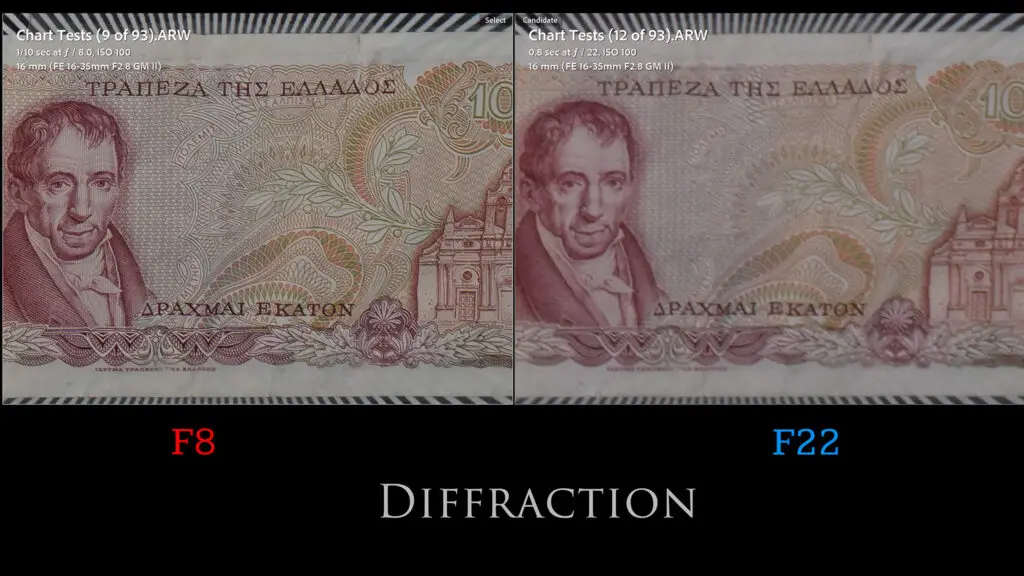
I was personally interested in how this GM lens compares to another brilliant 16mm lens that I reviewed earlier this year – the Viltrox AF 16mm F1.8. That’s a prime lens, obviously, and so it has but one focal length but does have the advantage of being to open to a much wider maximum aperture (+1 1/3 stops). This GM lens lens is top notch at 16mm; can the much less expensive Viltrox compare?
In the center of the frame I give an edge to the GM lens. There just aren’t hardly any wide angle lenses that deliver this level of resolution, though the Viltrox is close.

There is a some give and take elsewhere in the frame, with some spots looking better for the GM and others favoring the Viltrox. The corners very slightly favor the Viltrox:
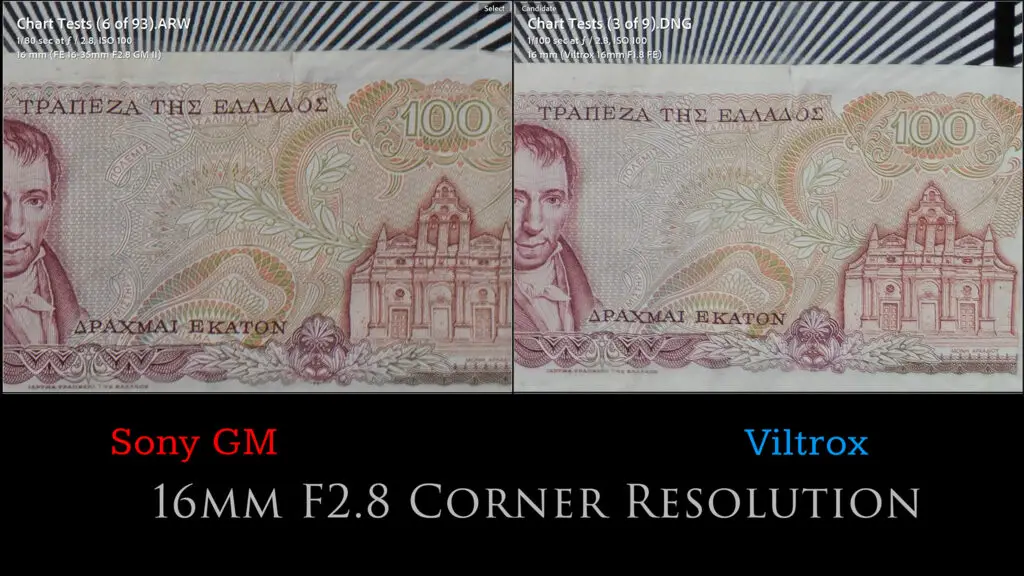
The two lenses are close in performance, which is frankly a win for both of them. That the Viltrox manages to compete with the 4x more expensive GM is impressive, and that the GM manages to equal the performance of one of the best wide angle primes that I’ve tested is also impressive.
Moving on in the zoom range, at 20mm I find that resolution is very similar, though I think contrast is just a hair off what I saw at 16mm (the bright areas are a little brighter at equivalent settings at 16mm).

Resolution remains at a very high level, obviously, and stopping down to F4 shows a more marked uptick in contrast than what I saw at 16mm (there was a little more room for improvement at 20mm). At F4 contrast is at very impressive levels.

You can capture beautiful results at 20mm for real world shots:

24mm is virtually identical to 20mm in my tests. I could scarcely spot a difference in either contrast or detail even at 200% side by side. Real world results are (as you would expect) impressive:

28mm was very slightly softer than at any point previously at F2.8:

As before, however, all it takes is a mild stop down to F4 to get into excellent levels. That means that real world images are going to look as excellent as you’d expect from this lens:

35mm proved sharper than 28mm in the center of the frame, but it was hit and miss elsewhere. 16mm seems to still be the most consistently uniform focal length in terms of sharpness and contrast, but 35mm isn’t far behind (16mm on the left, 35mm on the right):

As with most zoom lenses, my images were concentrated on the extremes, with slightly more taken at 16mm than at 35mm. In some ways I was more impressed with images at 35mm, however, for the simple reason that they tended to be closer and allowed me to appreciate the fine details more.

Wide angle zooms are rarely the source of the world’s best bokeh, but the 16-35GMII is better than most. Bokeh manages to not have too much outlining and is fairly creamy. The geometry for specular highlights also looks quite good.

Here’s another shot that shows a nice subject separation and a reasonably soft background.

Coatings on Sony’s recent GM lenses have proven excellent in resisting flare, and I did find that flare issues were basically non-existent.

A friendly clear night gave me the ability to test for coma. It probably should come as no surprise at this point that the 16-35GMII is also good at controlling coma. There’s a little bit of stretching on the edges of the frame, but little sign of coma smear. Star points are nice and crisp throughout the frame even when reviewed at 150% magnification.



Sony has really set the bar very high for their GM lenses starting at the 24mm F1.4 GM. I haven’t seen a bad one. They are expensive, yes, but they are the superlative lenses in their classes, and that’s kind of the the point.

Feel free to check out the image gallery to see more images.
Conclusion
The Sony FE 16-35mm F2.8 GM II has the most consistent performance I’ve ever seen from a wide angle zoom lens. Gone are the days when I was reviewing the premium Canon EF 16-35mm F2.8L II and despairing at the soft corners; we are in a whole new level of performance in the current era of Sony’s lens design.

Sony has achieved all the checklists here. The lens is smaller and lighter, more feature rich, has amazing autofocus, and incredible image quality.

There are cheaper alternatives, but nothing that provides the consistent performance in all areas that the 16-35GMII does. Does that make it worth $2300 USD? Only if you want the best…

Pros:
- Shorter and lighter than MK 1 lens
- Feature rich design
- Option to declick the aperture
- Advanced weather sealing
- Quad XD linear motors
- Fast, silent, and accurate autofocus
- Good video AF
- Low focus breathing
- Incredibly sharp lens across zoom range
- Near perfect image quality at landscape apertures
- Great contrast and color saturation
- Nice bokeh
- No fringing
- Vignette well controlled
- Flare resistance near perfect
- Good control of coma
- High magnification
Cons:
- Complex barrel distortion at 16mm
- Expensive
_________________________________________________________________________
GEAR USED:
Purchase the Sony 16-35mm F2.8 GM II @ B&H Photo | Adorama | Amazon | Camera Canada | Sony Canada | Amazon Canada | Amazon UK | Amazon Germany
___________________________________________________________________
Purchase the Sony a7RV @ B&H Photo | Adorama | Amazon | Camera Canada | Sony Canada | Amazon Canada | Amazon UK | Amazon Germany
__________________________________________________________________
Purchase the Sony a7IV @ B&H Photo | Adorama | Amazon | Camera Canada | Sony Canada | Amazon Canada | Amazon UK | Amazon Germany
_________________________________________________________________
Purchase the Sony Alpha 1 @ Camera Canada | B&H Photo | Adorama | Amazon | Sony Canada | Amazon Canada | Amazon UK | Amazon Germany | Ebay
_________________________________________________________________
Want to support this channel? Use these affiliate links to shop at: B&H Photo | Amazon | Adorama | Camera Canada | Amazon Canada | Amazon UK | Ebay | Make a donation via Paypal
Buy DA Merchandise https://bit.ly/TWIMerch
Keywords: Sony 16-35mm, Sony FE 16-35mm F2.8 GM II, G Master, GM, II, MK II, SEL1635GM2, #SEL1635GM2, Full Frame, Review, Sony Alpha 1, Sony a7RV, Review, Hands On, Dustin Abbott, Real World, Comparison, Sharpness, Bokeh, Flare Resistance, Autofocus, Image Quality, Sample Images, Video, Photography, let the light in, weathersealing, #letthelightin, DA
DISCLAIMER: This article and description contains affiliate links, which means that if you click on one of the product links, I’ll receive a small commission. As an Amazon Associate I earn from qualifying purchases.










 Viltrox Pro AF 85mm F1.4 FE Gallery
Viltrox Pro AF 85mm F1.4 FE Gallery  Viltrox AF 85mm F1.4 PRO FE Review
Viltrox AF 85mm F1.4 PRO FE Review  Yongnuo YN 35mm F1.8 ART Gallery
Yongnuo YN 35mm F1.8 ART Gallery  Yongnuo YN 35mm F1.8 DA ART Review
Yongnuo YN 35mm F1.8 DA ART Review 


